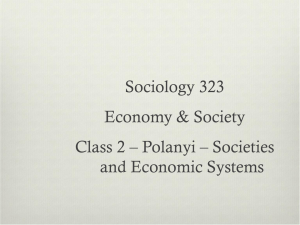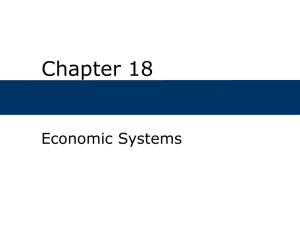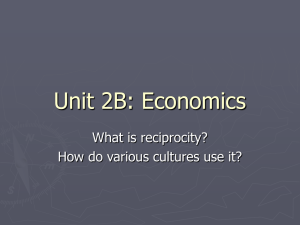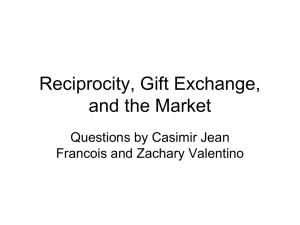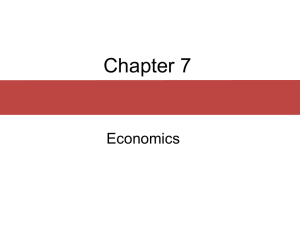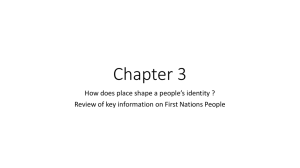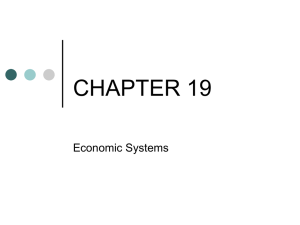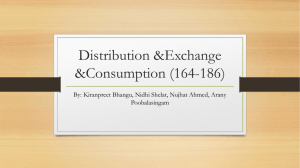p164 – 186
advertisement
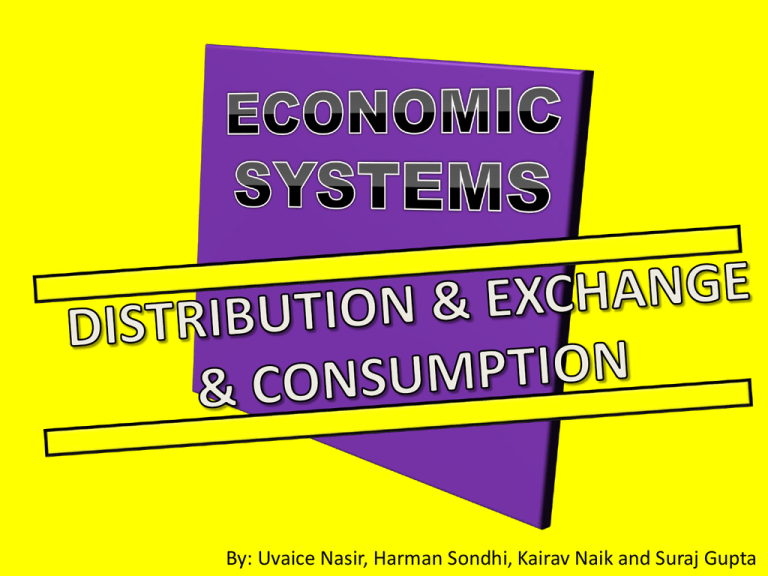
By: Uvaice Nasir, Harman Sondhi, Kairav Naik and Suraj Gupta • In cultures without money as a medium of exchange, the rewards for labour are direct • The workers in a family group consume what they harvest, eat what the hunter/gatherer brings home and they use the tools they make themselves • Even when no formal exchange medium exists, distribution of goods occurs • Karl Polanyi classified these cultures into three modes; reciprocity, redistribution, and market exchange • definition (reciprocity): the exchange of goods and services of approximately equal value between two parties • The main motive is to fulfill social obligations and gain prestige in the process; in North American society, it can be compared to someone throwing a party • Impress others through the food and drinks served along with the types of conversations made • Social customs dictate the nature and occasion of exchange (for example, each person in a camp of Aboriginal hunters gets a share, the size depending on the nature of the person’s kinship tie to the hunters) • Giving and receiving is obligatory (if the hunter does not follow the rules of distribution, that hunter will not get the same amount of food as the rest in the future, when another hunter brings food to the camp) • This ensures community bonds and ensures that everyone eats • definition (generalized reciprocity): a mode of exchange in which the value of the gift is NOT calculated, nor is the time of repayment specified • Gift giving and the act of a Good Samaritan (someone who stops to help someone else in distress) fall into this category • Most generalized reciprocity occurs among close kin • In North America, the homeless use generalized reciprocity to ensure the group's survival • definition (balanced reciprocity): a mode of exchange whereby the giving and the receiving ARE specific in terms of the value of the goods and the time of their delivery • Examples of balanced reciprocity in North America include trading baseball cards and buying drinks, among a group of friends, when it’s your turn • Non-Western culture example: a woman of the Crow (as observed by Robert Lowie) who is skilled in tanning of buffalo hides might offer her service to a neighbour who is in need of a new tipi cover. In return, the designer herself would receive some type of property by the tipi owner • definition (negative reciprocity): a form of exchange whereby the giver tries to get the better of the exchange • The parties involved have opposing interests, are members of different communities, and are NOT closely related • Ultimate form of negative reciprocity: trying to take something by force • Example in North America: a car salesperson who misleads buyers into purchasing a car of poor quality • Navajo: “to deceive when trading with foreign peoples is morally accepted” • Barter is a form of negative reciprocity, that involves the exchange of scarce items from one group for desirable goods from another group • Both balance reciprocity and barter used between the Woodland and Plains Cree • For nearly two centuries, both the Woodland and Plain Cree dominated European trade and technology • Symbiotic relationship between the Cree and Europeans: the Cree became trappers in exchange for firearms and high quality beads, blankets, pots/pans, and fabric • The European traders made a lot of profit bartering for robes and pelt from other First Nations groups, selling fresh bison meat to fur trade posts and trading goods they had acquired from Europeans to other First Nations groups • The Assiniboine also served as intermediaries between European fur companies and First Nations groups • When fur trade moved west, so did the Assiniboine; adopted plains lifestyle becoming bison hunters • By mid 18th century, they were highly regarded as traders due to arrival of guns and horses • definition (silent trade) : a specialized form of barter with NO verbal communication (usually no face-to face contact at all) • Seen between food foraging people and their food producing neighbours (former have supplied, for past 2000 years, various commodities in demand) • Process: forest people go to trading place and leave a pile of products like wax, monkeys’ gall bladders and birds’ nests for Chinese soup. They retreat and the partners enter, lay down “equal” products (metal cutting tools, bananas, etc.), and they too leave. The forest people return and take the second pile if it is agreeable and then the second partners return and take the first pile presented by the forest people • Silent trade may 1) be a work-around for lack of common language 2) control situations of distrust and 3) make exchange possible where problems of status might make verbal communication unthinkable • In the end, silent trade provides for the exchange of goods between groups in spite of potential barriers • Not all trade is motivated by economic considerations • The Kula Ring is a Trobriand inter-island trading system whereby prestige items are ceremoniously exchanged • Men set sail in their canoes to exchange shell valuables with their Kula partners, who live on distant islands • The items include red shell necklaces and white arm shells which are ranked by size, colour, how finely polished they are and their particular histories • These valuables are not held for very long by the men (max ~ 10 years), as it risks disrupting the path it must follow from one partner to another • Trobriand men seek to create history through the exchange. • By circulating armbands and necklaces that accumulate the histories of their travels and names of those who have possessed them, men proclaim their individual fame and talent, gaining considerable influence for themselves in the process. • Although the idea is to match the size and value of one shell for another, men use their negotiation skills, material resources and magical expertise to gain the strongest partners and most valuable shells • Negative Reciprocity: arises when man diverts shell from “path” or entices others to compete; however, success is limited! • Elaborate complex of ceremony, political relationships, economic exchange, religion and social integration • The Kula demonstrates how inseparable economic matters are from the rest of the culture • Example in modern industrial societies: United States stopped trading with Cuba, Haiti, Iraq and Siberia due to political reasons; economic embargoes were increasingly popular as political weapons both government and special-interest groups wield • Consider the following: retail activity in Canada peaks in December. Why? • definition (redistribution): a form of exchange in which goods flow into a central place where they are sorted, counted, and reallocated • In cultures with sufficient surplus to support some sort of centralized authority, income flows into the public coffers in the form of gifts, taxes, and the spoils of war; then it is distributed again. • 3 motives: to maintain a position of superiority through a display of wealth; to assure those who support the agent an adequate standard of living; and to establish alliances outside of agent’s territory • The administration of the Inca empire in Peru was one of the most efficient the world has ever known, both in the collection of taxes and methods of control • Tributes in goods and in services were levied; each craft specialist had to produce a specific quota of goods; forced labour was used for agricultural work as well as for public works • Though the activities of the centralized authority (i.e. government bureaucracy), redistribution took place • This exchange is not between individuals or between groups, but, rather, products are funneled into one source and parceled out again as directed by a central administration • Involves an element of coercion • Example of redistribution in NA: people pay taxes to government which are redistributed to support social programs, government services, etc. • With the growth of federal deficit over the last few years, wealth in Canada has been redistributed from middle class to wealthy holders of government securities • For redistribution to be possible, a society must have a centralized system of political organization, as well as an economic surplus beyond people’s immediate needs. • definition (levelling mechanism): a societal obligation compelling people to redistribute goods so that no one accumulates more wealth than anyone else. • Used in cultures where people devote most of their time to subsistence strategies -> gradations of wealth are small -> systems of reciprocity serve to distribute wealth • definition (conspicuous consumption): a term Thorstein Veblen (economist) coined to describe the display of wealth for social prestige • Strong motivating force in cultures where a substantial surplus is produced • Plays a prominent role in Western societies – that is to say, economies based on consumer wants • definition (potlatch): a special celebration in which the people of a community come together to enjoy elaborate feasts, ceremonial dancing, and gift giving. The potlatch serves as an opportunity for chiefs to enhance their status with public displays of generosity • What is it? A form of conspicuous consumption in nonindustrial societies: example of First Nations groups (like the Kwakwaka’wakw and Tsimshian) on the northwest coast of North America • They place great emphasis on inherited rank and privileges • The potlatch also showcases the host’s status • An important component of a potlatch is the gift giving • Fun Fact: in the Chinook language, the word “potlatch” means “gift” • Everybody receives gift and the value of gifts is based on the guest’s rank • Today, gifts are more likely to be money; crafts such as embroidered or crocheted doilies; housewares; clothing; and dry goods • The spiritual component of the potlatch publically announced and validated symbolic property, such as assuming a new name • Masked dancers , who represent supernatural forces, announced these privileges • The Kwakwaka’wakw held potlatches to mark critical stages of life: birth, puberty, death • Some view the potlatch as competitive (like among the Kwakwaka’wakw), while in other First Nations groups (like the Nuu-chah-nulth and Salish), this was not the case • Others recognize it as a means of communication, establishing bonds and support networks between people of one community, as well as between members of more than one community • It may also have been used to ensure that other communities received adequate resources • Not only serves as system of economic redistribution but also as a levelling mechanism • Potlatches reached their heyday during 18th and 19th centuries • Note: many First Nations coastal groups continue to hold potlatches today! • Late 1800s = time of “revenge potlatches”; wealthy rival chiefs tried to outdo each other by holding the most extravagant potlatch • These potlatches were a response to economic and social pressures experience by First Nations coastal peoples when Europeans arrived • Europeans, especially missionaries, viewed these ceremonies wasteful and in 1884, they were banned by the Canadian government • Intervention of government failed to consider that the potlatches accomplished many social, economic and political goals for the northwest coastal people • Fun Fact: even when it remained illegal (1884-1951), many groups secretly continued the practice • Unlike in Western societies, the potlatching system did not hoard goods, but rather gave them away • In fact, today the gift-giving part is called “give-away” • Conclusion: served to develop social, economic and political relationships; way to publicly and officially recognize inheritance rights and individual status; form of economic redistribution • definition (market exchange): the buying and selling of goods and services, with prices set by the powers of supply and demand • Loyalties and value are not supposed to play a role in market exchange, but in reality, they often do • WHERE the buying and selling takes place is largely irrelevant • Some modern market transactions do occur in a specific identifiable location (ex: trade in cotton happens in the New Orleans Cotton Exchange) • However, it is much more common in the modern market of North America to buy or sell goods without being on the same side of the continent as the other party • With the advent of the internet, a new economy, based on ecommerce, has emerged • The concept of “shopping” is changing • Until well into the 20th century, market exchange typically was carried out in specific places, as it still is in much of the non-Western world • In peasant or agrarian societies, marketplaces overseen by a centralized political authority provide the opportunity for farmers living in rural regions to exchange some of their livestock and produce for needed items manufactured in factories or the workshops of a craft specialist • Therefore, some sort of complex division of labour as well as centralized political organization is necessary for the appearance of markets • What happens in these marketplaces has little to do with the price of land, the amount paid for labour, or the cost of service • In this way, these marketplaces are dissimilar from Western marketplaces • The market is local, specific, and contained. Prices are apt to be set on the basis of face-to-face bargaining (buy low, sell high is the order of the day) • No form of money is needed to be involved in the transaction; instead, goods may be directly exchanged through some form of reciprocity between the specific individuals involved • Non-Western marketplaces have much of the excitement of a fair; they are vibrant places were an individual’s senses are assaulted by a host of colourful sights, sounds and smells • Many of the large urban and suburban malls built in Canada and other industrialized countries over the past few decades have tried to recreate, although in a more contrived manner, some of the interest and excitement of more traditional marketplaces • Social relationships are even important in this setting • Anthropologist Stuart Platter observes, the market place is where friends are made, love affairs begin, and marriages arranged • Dancers and musicians may perform • The end of the day may be marked by drinking, dancing, or fighting • At the market place, people may also gather to hear news or indulge in gossip Aztecan Market Place • the Aztecs were required by law to go to the market at specific intervals to keep informed about current events • Government officials held court and settled judicial disputes at the market • Thus, the marketplace became a gathering place where people renew friendships, see relatives, gossip, and keep up with the world while procuring needed goods they cannot produce for themselves Money • Although marketplaces can exist without any sort of money exchange, no one doubts that money facilitates trade • definition (money): anything used to make payments for goods or labour as well as to measure their value; may be special-purpose or multipurpose • Money’s critical attributes are • • • • • durability portability divisibility recognizability fungibility (ability to substitute any item of money for any other monetary item of the same value, as when four quarters are substituted for a dollar bill) • The wide range of things that have been used as money in one or another society include salt, shells, stones, beads feathers, fur, bones, teeth, and of course metals, from iron to silver to gold • Among the Aztecs of Mexico, both cacao beans and cotton cloaks served as money • The beans could be used to purchase merchandise and labour, although usually as a supplement to barter; if the value of the items exchanged was not equal, cacao beans could be used to make up the difference • Cottons cloaks represent a higher denomination in the monetary system, with 65 to 300 beans equivalent to one cloak, depending on the latter’s quality • Cloaks could be used to obtain credit, to purchase land, as restitution for theft, and to ransom slaves, whose value in any case was measured in terms of cloaks • Interestingly, counterfeiting was not unknown to the Aztecs—unscrupulous people sometimes carefully peeled back the outer skin of cacao beans, removed contents, and then substituted packed earth • Among the Tiv of West Africa, brass rods might be exchanged for cattle, with the cattle seller then using the rods to purchase slaves (the economic value of the cattle being converted into the rods and then reconverted into slaves) • In both the Aztec and Tiv cases, the money in question was used only for special purposes • To a Tiv, the idea of exchanging a brass rod for subsistence food is repugnant, and most market exchanges involve direct barter • Special-purpose monies usually have moral restrictions on their use than do general purpose monies, which can be used to purchase just about anything • For example in North America it is considered immoral, as well as illegal, to exchange money for sexual and political favours, even though infractions against these constraints occurs Marketplace Structures • In Canada and the United States, as part of the reaction to the growing “face-to-faceless” nature of modern economic system, there has been something of a revival and proliferation of “flea-markets” • Flea Market: a market where anyone, for a small fee, may display and sell handicrafts, second hand items, farm produce, paintings, etc. in a face-to-face setting -Excitement is felt in search for bargains and an opportunity for haggling -A carnival atmosphere prevails, eating, laughing, and items even may be bartered without any cash exchanging -Flea markets, garage sales, fairs, festivals, and farmer’s markets are similar to the market places of nonWestern societies -Flea markets raise the issue of formal and informal sectors of the market economy • definition (informal economy): the production of marketable commodities that for various reasons escape enumeration, regulation, or any other sort of public monitoring or auditing • These “off the book” activities have been dismissed by economists as aberrant and, therefore, more of an annoyance then anything important • It is also very difficult to track transactions within these informal economical sectors • Yet in many countries of the world, informal economy > formal economy • In many places, large number of under- and unemployed people who have only limited access to the formal sector, in effect, improvise as best they can various means of “getting by” on scant resources • Meanwhile more affluent society members may evade various regulations to maximize returns and to vent their frustrations at their perceived loss of self-determination in the face of increasing government regulation • Canada is preferred by immigrants for its stable economic and social environment, multiculturalism, ethnic diversity, AND economic opportunity • Chinese immigrants first came to Canada about 130 years ago to work on Canadian Pacific Railway (largest wave of immigrants in 1990s) • 1.4 million Chinese in Canada by 1997 • Brought finances, skills, and infectious entrepreneurial spirit • They opened up small businesses, which led to vibrant Chinese commercial districts • They send their children to school and have fuelled real estate marked in places like Vancouver • Those looking at investments in Canada brought along enormous sums of money • Contribution from Hong-Kong Chinese immigrants helped Canada during recessionary times • Charities: Tzu Chi Buddhist foundation donated six million to Vancouver hospital • Contribution to Canadian culture: dragon boat races and Chinese New Year’s celebrations (boosts local economy as well) • Ethnic foods (such as dim sum) led to opening of many Chinese restaurants, helping to create a cosmopolitan atmosphere in major cities • Chinatowns, or Chinese shopping centres, create employment to many Chinese people, including refugees • Chinese immigrants make up the majority of the 3 million Asian people who have come to Canada • However, many other Asian groups make up the multicultural mosaic (ex. Japanese people came to Canada in the 1890s to work as merchants and fishers; population = 120,000) • Korean (population of 130,000) and Vietnamese (170,000) people have also contributed to Canadian economy • Ultimately, Asian migration to Canada has resulted in a tremendous expansion of the Canadian economy • definition (consumption): the ingestion of food and exploitation of available resources • 3rd component of economic system • Two perspectives: (1) food and beverages that we consume and the accompanying rituals and customs; (2) resources that we exploit in our everyday lives • Purpose of consumption? To meet our basic needs for food, liquid and protection from the elements; it also fulfils our wants and desires • Needs and wants differ from culture to culture but all are intended to make our lives more confortable • Consumption habits in industrial societies have grown dramatically, as demonstrated by the 2003 blackout in eastern North America • Consumption demands of foragers are much less • In societies that have adopted new forms of production(e.g. nomadic pastoralists forced to settle in one place and become agriculturalists) people often have difficulties fulfilling their consumption needs and wants • Modern communication, like computers, has increased consumption • People used to eat with their hands before utensils were made; some still use hands • Utensils started out as tools when hunters used them to cut meat • Spoons: – Made out of halved gourds, seashells or carved wood – Used to dip out of communal stew pot – Status and ranking determined who would dip first; men, then women and children • Fork: – Created in the Middle Ages; spread from Italy to England to France – Adoption of fork is gender determined • Gentlewomen always carried their forks • Men used knives and fingers • Some use chopsticks • Gestures of appreciation vary in culture – e.g. slurping soup • Rude in North America but considered to show appreciation of cook in Japan – e.g. leaving a spoon or chopstick in rice • Symbolizes use by dead in Korea • Many taboos regarding what people can and cannot eat – E.g. Hawaiian women could not touch certain types of foods (e.g. pork, coconuts, fish), could not eat with men and could not cook their food in the same oven as men – E.g. Muslims and Jews do not eat pork – E.g. Hindus do not eat cows • Fasting is also a taboo – Ukrainians do not eat meat on Christmas Eve • Gender determined food taboo – E.g. women were not allowed alcohol • Food is used as connection between humans and God – E.g. sacrifices, ritual transactions – E.g. Hindus offer food to deity before consuming it themselves – E.g. Ukrainians have blessings of food figures such as babka and paska that are taken to church to be blessed • Food is also important for forming and maintaining a social group – E.g. social gatherings like weddings, bar mitzvahs and funerals offer certain types of foods • Canada, a pluralistic country, also contributes to ethnic food systems THE END!

